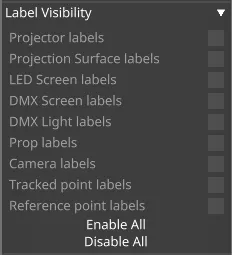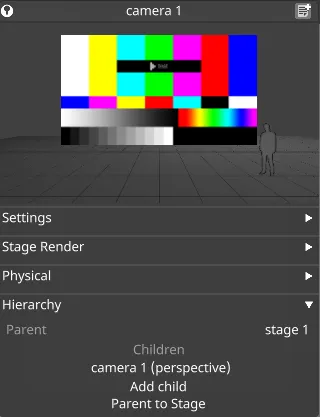Camera Properties
Cameras can be configured according to the properties of the real- world cameras they represent.
To create a camera and amend camera properties:
- Open the stage editor by right-clicking stage from the dashboard or by right-clicking the floor in the visualiser.
- Expand the Cameras tab.

- Right-click a camera from the list or create a new one.
- Adjust the desired properties of the camera using the editor.

Settings

Offset
The offset in meters of the camera’s position from its parent. When parented to the stage which is the default this is the camera’s world position.
Rotation
The rotation transformation in degrees from its parent. When parented to the stage, which is the default, this is the camera’s world rotation.####
Tracking source
See Object tracking source for more information.
Resolution Source (visualiser camera only)
- Take from GUI - Default, Use the resolution of the GUI display.
- Fixed - You can specify a custom resolution. Will not change the resolution of the display, only the camera’s view.
Resolution
The resolution that the camera will use to render its view.
Field of view (vertical)
The vertical field of view in degrees of the camera.
Field of view (horizontal)
The horizontal field of view in degrees of the camera.
Preview

Camera plate
Sets the camera to Transmission, Backplate, or Frontplate.
Show Alpha
Toggles whether the camera will show Alpha or not.
Output

Set extension fade
Opacity of the set extension.
Set extension feather
Feather of the set extension. This is defined as the width of the feather.
Video input fade
Defines whether you have video input on or off. Helpful if you want to see how well the set extension is lined up.
AR fade
AR content on or off. Frontplate content only. Helpful to see how well the AR content is lined up.
Radial mask scale
Applies a radial mask to the film content.
Frontplate reprojection
- Backplate aligned
Front plate is delayed and reprojected with the backplate so frontplate and backplate content are displayed in sync. This is the default.
- No reprojection
Frontplate is delayed along with the backplate content but is not reprojected. This is used for frontplate content that aligns more with the filmed content.
- Minimal latency
Backplate image and frontplate images are taken from two different points in time. This results in the latest frontpate frame being displayed.
Frontplate composite order
Defines how content assigned to frontplate is ordered in the composite stack.
Colour LUT
Defines which LUT is applied to the camera. Designer has a number of LUT files built in.
Colour profile
Defines which colour profile the camera is. Designer has a number of colour profiles built in.
Hold output
Hold output freezes the current frame of the camera output. This is a toggle setting.
Stage Render

Render Settings
Multiple render setting configurations can be created for each camera.
Right-click on Default to open the Default configuration; left-click on Default to open the StageRenderSettings list manager to create a new configuration or recall an existing one.
Render settings can be configured for these properties:
- Object Visibility
- Label Visibility
- Renderer
Object Visibility

Projectors
- *Hidden - hides projector from the view
- Beam - Shows projector beam only
- Wire - Shows projector wireframe only
- Beam and wire (default)- Shows projector beam and wireframe.
Measurements
Hidden (default) - hides measurements from view. Visible - shows measurements in view.
Cameras
Turn on or off the visibility of Cameras.
People
- Visible (default) - People are visible in the view.
- Hidden - People are hidden from the view.
Venue
- Visible (default) - Venue is visible in the view.
- Hidden - Venue is hidden from the view.
Tracked points
- Visible - Tracked points from Blacktrax are visible in the view.
- Hidden (default) - Tracked points from Blacktrax are not visible in the view.
Movement Speed
- Visible - Movement speed is visible in the view.
- Hidden (default) - Movement speed is not visible in the view.
Floor
- Visible (default) - The floor is visible in the view.
- Hidden - The floor is not visible in the view.
Fixture
- Visible (default) - Fixtures are visible in the view.
- Hidden - Fixtures are not visible in the view.
Reference Points
- Visible (default) - Blacktrax reference points are visible in the view.
- Hidden - Blacktrax reference points are not visible in the view.
Virtual Object Alpha
Opacity of virtual objects in render layers other than onstage or offstage
Label Visibility

Projector Labels
Labels for projectors only.
Projection Surface Labels
Labels for projection surfaces only.
LED Screen labels
Labels for LED screens only.
DMX Screen Labels
Labels for DMX Screens only.
DMX Light Labels
Labels for DMX Fixtures only.
Prop Labels
Labels for props only.
Camera Labels
Labels for cameras.
Tracked Point Labels
Labels for tracked points only.
Reference Point Labels
Labels for reference points only.
Renderer

- Renderer
- Light
- White Point
- Ambient Occlusion
- Glow Brightness
- Background colour
- Anti-aliasing
Renderer
- Schematic - Uses the Schematic renderer.
- Lux - Uses the Lux renderer.
- Heatmap - Uses the Heatmap renderer.
Light (only available for Heatmap)
- Luminance - Luminance - The intensity of light emitting from an object or surface per meter in a given direction, measured in nits (cd/m²)
- Illuminance - The density of incident light in lumens hitting a surface per meter, measured in lux (lm/m²).
White point
Camera exposure in lux.
Ambient occlusion power
Power of the ambient occlusion effect in the lux renderer. 0 disables it.
Glow brightness
Impact of glow effect in lux renderer.
Background colour
Changes the background colour of the scene. In Schematic, this will be the background colour.
In Lux, this will be the base colour of the environment and is affected by lighting. For example, if the ambient light is 0 the background will be black regardless of the colour.
In Heathmap, the background is always black.
Anti-aliasing
Anti-aliasing can smooth out jagged edges caused by aliasing. The higher the number the smoother aliasing, but at more of a performance cost.
Face Cull Mode
Used to temporarily disable rendering of faces with normals pointing to the front or to the back

Stage Render > Camera type
- Perspective - Perspective view.
- Orthographic - Orthographic view.
Orthographic scale
Orthographic Camera has no concept of depth and distance from the scene. A zoom-like effect can be achieved by adjusting the Orthographic Scale, but this setting is independent from Zoom in the equivalent Perspective Camera.
Near & Far clipping plane
Any geometry closer than the near-clipping plane or further than the far-clipping plane will clipped (not be rendered). The values are in meters.
Reducing the range of these values can improve shadow quality and reduce shadow acne.
Physical

Video in
Defines the live video input this camera is linked to.
Live action position marker
Used as a reference to re-align filmed content when using virtual zoom.
Spatial calibration
Used to create spatial calibration configurations
Video receive delay (sec)
Roundtrip latency time calculated from calibration process.
Spatial Tracker delay (sec)
Amount of time in seconds between the camera frame arriving and the tracking data associated with it arriving. This is calibrated automatically.
Lens Tracker delay (sec)
Allows for adjustment to the time needed to sync between lens and tracking data.
Lens
Overscan
Defines the overscan ratio. The Default is 1. Setting to 1.1 would mean an overscan of 10%. The higher the overscan, the higher the performance impact.
Overscan resolution
Overscan resolution is the readout value in resolution of the overscan values.
Aspect ratio
This is a readout value of the final aspect ratio of the camera.
Focal length
This is a readout value of the calculated focal length of the camera.
Sensor width
Defines the sensor width.
Centre shift
Offset of the focal point of the lens from the centre of the light sensor, measured in mm.
K1, K2, K3
- k1 - First order radial distortion coefficient, as measured.
- k2 - Second order radial distortion coefficient, as measured. = k3 - Third order radial distortion coefficient, as measured.
Prediction
Camera imaging delay (sec)
The amount of time between Designer outputting the frame and capturing the image. Prediction is turned off when this value is zero. If you want to turn prediction on, increase this value until the image looks good. Do not increase beyond the Video Receive Delay value.
Camera imaging delay prediction samples
How much of the history of the tracking data to predict into the future. Expressed in frames.
Camera imaging delay prediction terms
How many terms we used to model the movement. Two terms is linear. Three terms is a cubic prediction.
Hierarchy

Parent
Shows the parent object (this is usually the stage, so the object will be offset from the origin point of the stage).
Children
Shows children of the object.
- Click Add child to create a parent/child relationship between this object and another.
- Click Parent to stage to re-parent the object back to the stages origin point.